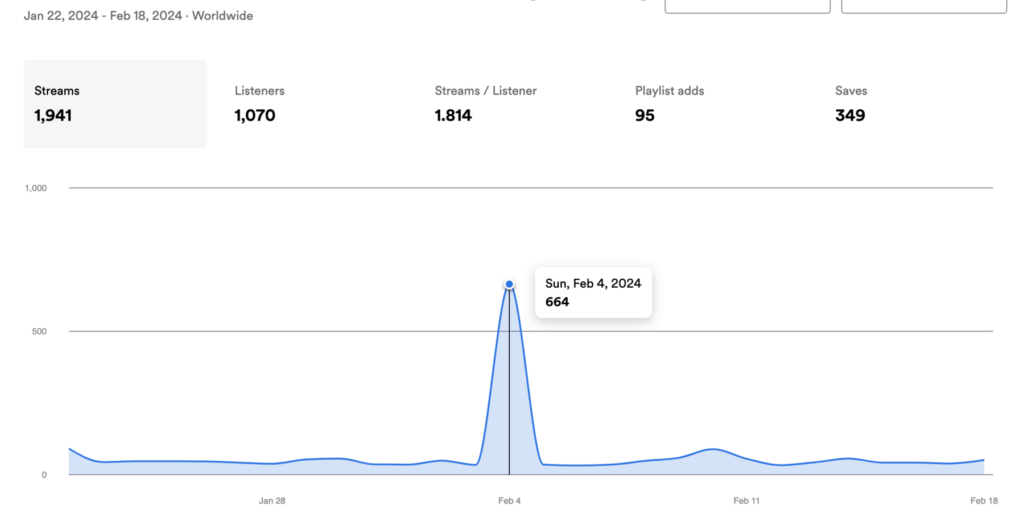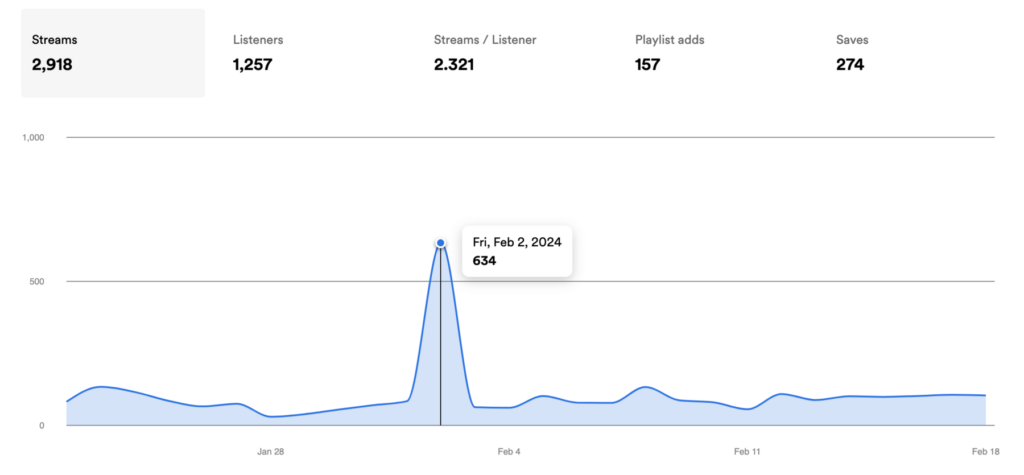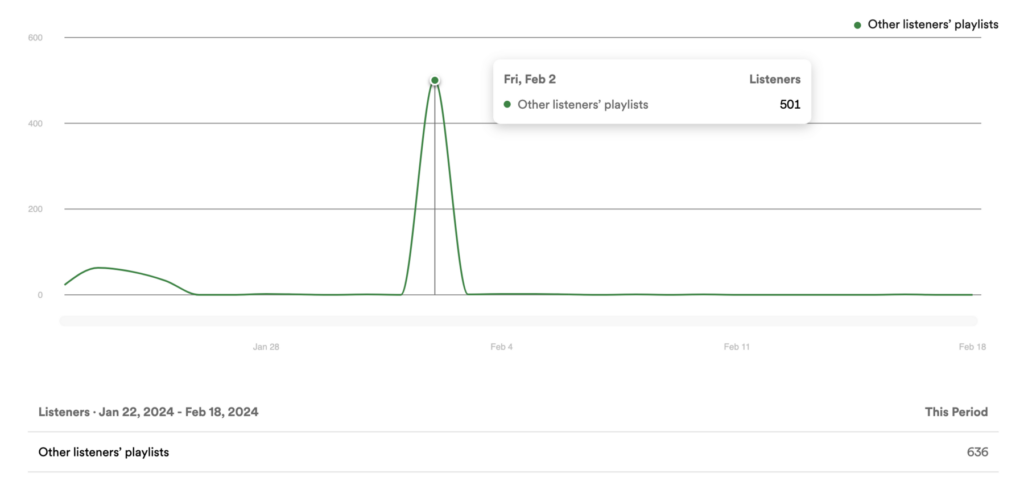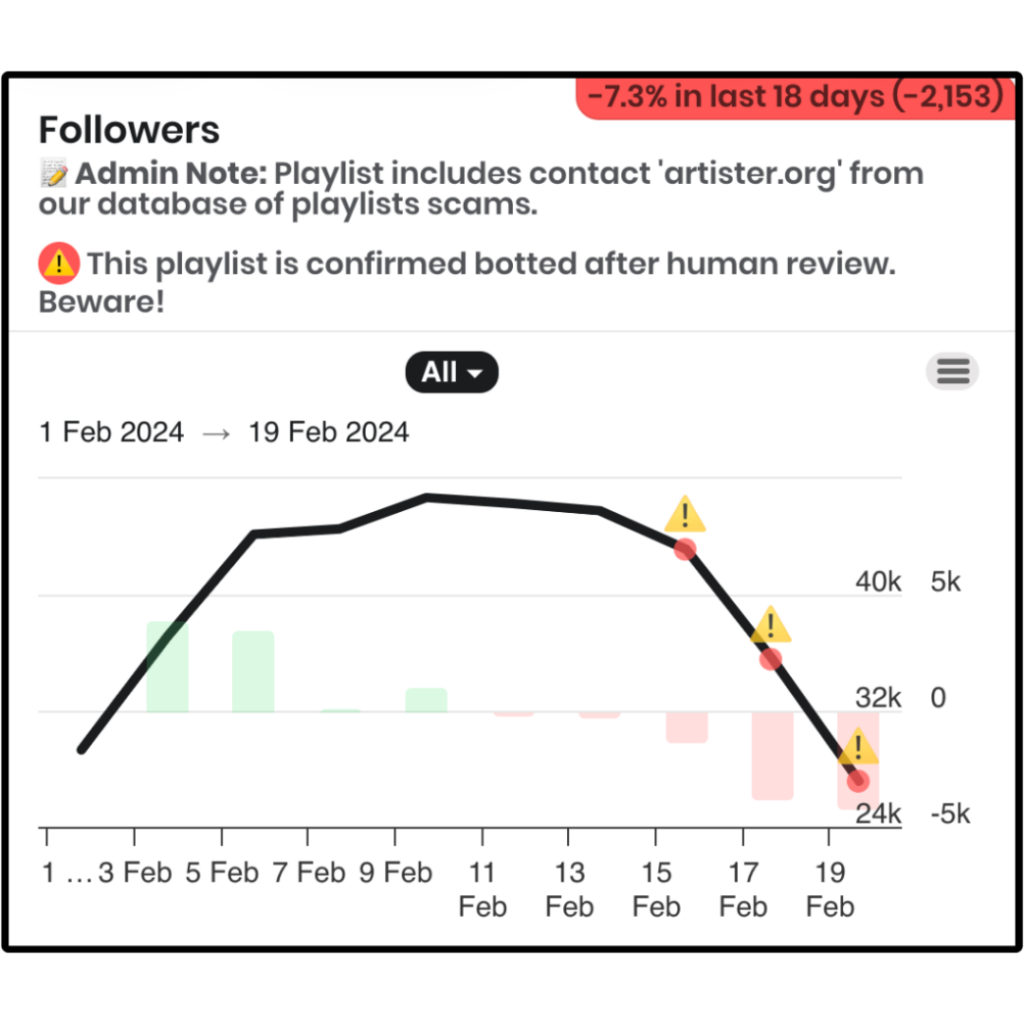Here are some words I wrote about a year ago:
“I’m tired of artists calling things ‘scams.’ Most things just are not scams. Most people in this industry are trying really hard to do good work. I think our tendency to call things scams is symptomatic of an underlying cultural issue: We’re a grace-impoverished people.”
Damn. Preach, Past Jon, preach.
Here’s the full piece, if you’re interested. I just read it for the first time in like ten months, and darn if I don’t still think it’s pretty good (if a bit self-righteous).
So I’m not out to eat my words in today’s post. But I do want to add some additional context:
Some things really are scams.
And I’ve seen one scam, specifically, going around a lot lately, which is what’s prompted me to write this post.
Here’s what it looks like.
You get a big spike in streams from a random third-party playlist.
For most artists, we’re talking something way out of the norm, like this:



Yes, these are real screenshots from three different artists.
If you’re the grounded, sensible sort of person who checks your Spotify for Artists stats sixteen times each day like me, you may very well see this spike as it happens.
When you log in for your usual 2:17pm check-in, instead of seeing “2 people listening now,” you’ll see “28 people listening now,” or “42 people listening now,” or whatever. This is exciting, and it will cause your mind to spin off into exciting, fantastical narratives.
“The crowds have arrived! My music is finally being recognized for the genre-defying art that it is! I’m going to be more famous than Bieber! Cover shoot for Better Homes and Gardens, here I come!”
Then, a day or two later, your audience spike will subside, and you’ll be left with the streaming equivalent of a caffeine crash – back where you started, only feeling worse about it.
When you emerge from your stupor and dig a little deeper to uncover the source of your sudden spike in streams, here’s what you’ll see:

Yeah. Virtually all of the spikes in those screenshots above are attributable to “Other listeners’ playlists.”
Now, if the spike lasted for more than a day, you might be able to take it as a sign that your music had connected with some legitimate tastemaker. There are real curators in the world, after all!
But given the fact that each of the spikes above only lasted for a day or so, there’s got to be something else going on, right?
Right.
Here’s what’s really going on:
- Scam companies add music from small indie artists to their own big playlists.
- The artists see the spikes and get excited.
- The company removes the songs from the playlist.
- Some artists reach out to the company to see what’s going on.
- The company says they can re-add the artist to the playlist – for a fee.
Still, if this was the full story, I don’t know that I’d classify it as a scam. The whole thing is a bit like throwing free samples at passerby in public; maybe it’s a little obnoxious, but it’s not explicitly dishonest.
But here’s the kicker: In my experience, every single company that uses this approach has built their playlists with bots.

If you can find the offending playlist and plug it into a checker like artist.tools (⬅️ that’s an affiliate link), you’ll see something like the screenshot above: unnatural spikes up and down that clearly signal bot activity.
Often (especially if you don’t catch the spike for a week or so) you won’t even be able to find the playlist that drove all your streams, because it will no longer exist. Spotify will have flagged it for bots and deleted it.
In other words, these companies are adding artists to botted playlists without permission, then trying to charge them for it – all while marketing their lists as “organic.”
If that’s not a scam, I don’t know what is.
And it kind of begs the next question:
What should you do about it?
The bad news is that there isn’t all that much you can do about the bot-based data in your account; you can’t manually delete it or anything like that. But you should follow these three simple steps:
- Curse your luck and shake your fist at the sky.
- Leave the company a negative review wherever you can.
- Report the playlist to Spotify by filling out the form here.
I don’t recommend the second step purely out of spite. It’s also a good way to let other artists know about the scam.
The third step, in all honesty, probably won’t result in any action you can see, but it’s also the most important. It may make a minor impact toward securing a good answer to the most-asked question artists have about this stuff, which is, of course…
“Will I be punished for the botted streams?”
The sad answer to this query is that you might be. Spotify has been known to remove songs that have accumulated botted streams, and as part of the platform’s recent royalty system change, they’ve promised to charge labels and distributors when “flagrant artificial streaming is detected on their content.”
There are all kinds of problems with this (and distributors like DistroKid are only making things worse), but that’s a post for another day.
My point here is that if you take the time to report the offending playlist to Spotify, you’ve done all you can do.
In actual fact, I have never seen Spotify remove a song in a situation where the artist reported the sketchy playlist. That’s anecdotal based on limited data, obviously, but it’s still good news.
And if you keep accumulating good streams so that the bot spike is clearly an isolated incident, honestly, your risks of major repercussions are pretty low.
Final thoughts
I’ll end with two final notes.
First, to be as transparent as possible: The two companies I’ve seen do this most frequently are Artister.io and Wavr.ai. If you’ve been considering working with either company – well, my advice is that you don’t.
Second, I stand by my words from a year ago: It’s much easier to hate than to hope, but hatred is poison for your soul. So rather than taking some twisted satisfaction in proving a service to be a scam, try to keep living in hope. Keep making music. Keep believing people are worth making music for.
That way of life is worth it – even if some playlisting services certainly aren’t.








